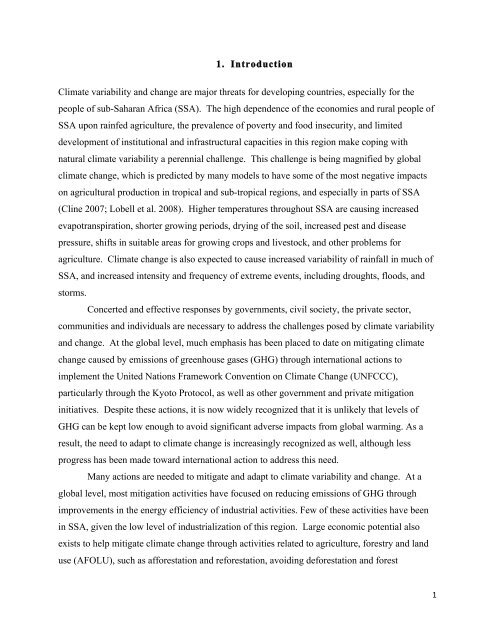The Role of Sustainable Land Management for Climate ... - CAADP
The Role of Sustainable Land Management for Climate ... - CAADP
The Role of Sustainable Land Management for Climate ... - CAADP
You also want an ePaper? Increase the reach of your titles
YUMPU automatically turns print PDFs into web optimized ePapers that Google loves.
!<br />
1. Introduction<br />
<strong>Climate</strong> variability and change are major threats <strong>for</strong> developing countries, especially <strong>for</strong> the<br />
people <strong>of</strong> sub-Saharan Africa (SSA). <strong>The</strong> high dependence <strong>of</strong> the economies and rural people <strong>of</strong><br />
SSA upon rainfed agriculture, the prevalence <strong>of</strong> poverty and food insecurity, and limited<br />
development <strong>of</strong> institutional and infrastructural capacities in this region make coping with<br />
natural climate variability a perennial challenge. This challenge is being magnified by global<br />
climate change, which is predicted by many models to have some <strong>of</strong> the most negative impacts<br />
on agricultural production in tropical and sub-tropical regions, and especially in parts <strong>of</strong> SSA<br />
(Cline 2007; Lobell et al. 2008). Higher temperatures throughout SSA are causing increased<br />
evapotranspiration, shorter growing periods, drying <strong>of</strong> the soil, increased pest and disease<br />
pressure, shifts in suitable areas <strong>for</strong> growing crops and livestock, and other problems <strong>for</strong><br />
agriculture. <strong>Climate</strong> change is also expected to cause increased variability <strong>of</strong> rainfall in much <strong>of</strong><br />
SSA, and increased intensity and frequency <strong>of</strong> extreme events, including droughts, floods, and<br />
storms.<br />
Concerted and effective responses by governments, civil society, the private sector,<br />
communities and individuals are necessary to address the challenges posed by climate variability<br />
and change. At the global level, much emphasis has been placed to date on mitigating climate<br />
change caused by emissions <strong>of</strong> greenhouse gases (GHG) through international actions to<br />
implement the United Nations Framework Convention on <strong>Climate</strong> Change (UNFCCC),<br />
particularly through the Kyoto Protocol, as well as other government and private mitigation<br />
initiatives. Despite these actions, it is now widely recognized that it is unlikely that levels <strong>of</strong><br />
GHG can be kept low enough to avoid significant adverse impacts from global warming. As a<br />
result, the need to adapt to climate change is increasingly recognized as well, although less<br />
progress has been made toward international action to address this need.<br />
Many actions are needed to mitigate and adapt to climate variability and change. At a<br />
global level, most mitigation activities have focused on reducing emissions <strong>of</strong> GHG through<br />
improvements in the energy efficiency <strong>of</strong> industrial activities. Few <strong>of</strong> these activities have been<br />
in SSA, given the low level <strong>of</strong> industrialization <strong>of</strong> this region. Large economic potential also<br />
exists to help mitigate climate change through activities related to agriculture, <strong>for</strong>estry and land<br />
use (AFOLU), such as af<strong>for</strong>estation and re<strong>for</strong>estation, avoiding de<strong>for</strong>estation and <strong>for</strong>est<br />
!<br />
$!

















